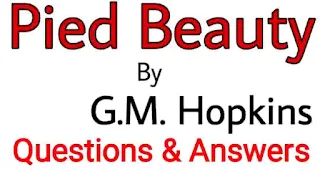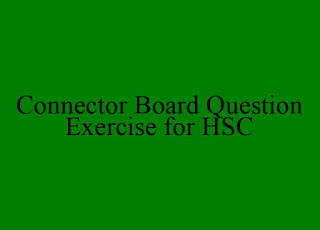Pied Beauty Poem Questions and Answers
Q.1. What kind of poem is “Pied Beauty”?
Answer: “Pied Beauty” is a curtal sonnet by the English poet Gerard Manley Hopkins (1844-1889).
Q.2. What is a curtal sonnet?
Answer: Curtal Sonnet an eleven line sonnet devised by Hopkins and featuring an abe abe, dbc de rhyme scheme.
Answer: Curtal Sonnet an eleven line sonnet devised by Hopkins and featuring an abe abe, dbc de rhyme scheme.
Q.3. In how many poems does Hopkins uses the form of curtal sonnet?
Answer: Hopkins uses the form of curtal sonnet in three of his poems and the poems are: “Pied Beauty”, “Peace” and “Ash Boughs.”
Answer: Hopkins uses the form of curtal sonnet in three of his poems and the poems are: “Pied Beauty”, “Peace” and “Ash Boughs.”
Q.4. When was “Pied Beauty” written and published?
Answer: It was written in 1877, but published in 1918, in Poems of Gerard Manley Hopkins.
Answer: It was written in 1877, but published in 1918, in Poems of Gerard Manley Hopkins.
Q.5. How does the poem “Pied Beauty” open?
Answer: The poem opens with an offering: “Glory be to God for dappled things.”
Q.6. To whom is the poem “Pied Beauty" addressed?
Answer: The poem “Pied Beauty" is addressed to the reader.
Answer: The poem “Pied Beauty" is addressed to the reader.
Q.7. What is the theme of the poem “Pied Beauty”?
Answer: The theme of the poem is Nature in its variety – including streaked, spotted, and multicoloured skies, fields, nuts, fish, birds, and other animals - is a gift of God for which we all should be thankful.
Answer: The theme of the poem is Nature in its variety – including streaked, spotted, and multicoloured skies, fields, nuts, fish, birds, and other animals - is a gift of God for which we all should be thankful.
Q.8. What does God symbolize in “Pied Beauty”?
Answer: In “Pied Beauty” God symbolizes what is constant and unchangeable.
Q.9. What metre is used in “Pied Beauty”?
Answer: The meter of “Pied Beauty” is sprung rhythm that permits an unlimited number of unstressed syllables in each line to accompany stressed syllables. A metric foot in sprung rhythm usually contains one to four syllables.
Answer: The meter of “Pied Beauty” is sprung rhythm that permits an unlimited number of unstressed syllables in each line to accompany stressed syllables. A metric foot in sprung rhythm usually contains one to four syllables.
Q.10. What is the rhyme scheme of the poem “Pied Beauty”?
Answer: The rhyme scheme of the poem is as follows: abc abc dbc dc.
Answer: The rhyme scheme of the poem is as follows: abc abc dbc dc.
Q.11. What is the tone of the poem “Pied Beauty”?
Answer: The tone is exuberant and spirited. The poem is a song of joy.
Q.12. Why does the speaker of “Pied Beauty" praises God?
Or, Why does the speaker pay homage to God? Answer: The speaker of “Pied Beauty” praises God for having created “dappled things” or multicoloured things in the world.
Or, Why does the speaker pay homage to God? Answer: The speaker of “Pied Beauty” praises God for having created “dappled things” or multicoloured things in the world.
Q.13. What are the most amazing things in the world?
Answer: The “dappled things” are the most amazing things in the world.
Q.14. What does the phrase “dappled things” mean?
Answer: The phrase “dappled things” means multicoloured or varie- gated things.
Answer: The phrase “dappled things” means multicoloured or varie- gated things.
Q.15. What was the colour of the skies?
Answer: The skies are twin coloured have two colours, most probably blue and white in a clear sky that is “dappled” or streaked with clouds.
Answer: The skies are twin coloured have two colours, most probably blue and white in a clear sky that is “dappled” or streaked with clouds.
Q.16. To what are the skies compared to?
Answer: The skies are compared to a brinded cow, that is, a cow having double colour. A brinded cow is brown and has marks of an other colour.
Answer: The skies are compared to a brinded cow, that is, a cow having double colour. A brinded cow is brown and has marks of an other colour.
Q.17. What is a brinded cow?
Answer: A brinded cow is a cow having double colour. A brinded cow is brown and has marks of another colour.
Answer: A brinded cow is a cow having double colour. A brinded cow is brown and has marks of another colour.
Q.18. “For skies of couple colour as a brinded cow” Identify the figure of speech used in the line?
Answer: The figure of speech used in the line is simile. Here the skies are directly compared to a brinded cow.
Answer: The figure of speech used in the line is simile. Here the skies are directly compared to a brinded cow.
Q.19. What is trout?
Answer: Trout is a kind of common river fish.
Answer: Trout is a kind of common river fish.
Q.20. What do rose- moles refer to?
Answer: The rose moles refer to the small light- reddish dots on the side of trout.
Answer: The rose moles refer to the small light- reddish dots on the side of trout.
Q.21. “For rose- moles all in stipple upon trout that swim;” - Identify the literary device used in the line
Answer: The literary device used in the line is metaphor. Here the spots on the side of the swimming trout are indirectly compared to moles.
Answer: The literary device used in the line is metaphor. Here the spots on the side of the swimming trout are indirectly compared to moles.
Q.22. “Fresh firecoal chestnut falls; finches wings” - What literary device is used here?
Answer: Here the first half of the line includes an implicit metaphor. comparing fallen chestnuts to coals in a fire.
Answer: Here the first half of the line includes an implicit metaphor. comparing fallen chestnuts to coals in a fire.
Q.23. How does the trout look like?
Answer: The trout have small light reddish dots resembling roses on their bodies.
Answer: The trout have small light reddish dots resembling roses on their bodies.
Q.24. What is stipple?
Answer: “Stipple” is a technique in arts like drawing, painting, and sewing, to create texture through the use of small dots.
Answer: “Stipple” is a technique in arts like drawing, painting, and sewing, to create texture through the use of small dots.
Q.25. What are the chestnut falls?
Answer: “Chestnut falls” refer to chestnuts that have fallen off the chestnut tree, When they are on a tree, chestnuts are covered by a spiky, light green covering, but the nuts themselves are reddish brown.
Answer: “Chestnut falls” refer to chestnuts that have fallen off the chestnut tree, When they are on a tree, chestnuts are covered by a spiky, light green covering, but the nuts themselves are reddish brown.
Q.26. To what are the chestnuts compared?
Answer: When the chestnuts fall they open to reveal the meaty interior normally concealed by the hard shell; so, they are compared to the coals in a fire, black on the outside and glowing within. These opened chestnuts also look like embers.
Answer: When the chestnuts fall they open to reveal the meaty interior normally concealed by the hard shell; so, they are compared to the coals in a fire, black on the outside and glowing within. These opened chestnuts also look like embers.
Q.27. What are finches?
Answer: Finches are small birds with multicoloured wings.
Answer: Finches are small birds with multicoloured wings.
Q.28. How are the wings of the finches?
Answer: The wings of the finches are multicoloured.
Answer: The wings of the finches are multicoloured.
Q.29. How is the English landscape?
Answer: The English landscape is divided up into different “plots” and “pieces” for farming and raising livestock.
Answer: The English landscape is divided up into different “plots” and “pieces” for farming and raising livestock.
Q.30. What is fallow?
Answer: “Fallow” is a field that has been left empty or uncultivated or unused.
Answer: “Fallow” is a field that has been left empty or uncultivated or unused.
Q.31. What is a fold?
Answer: A “fold” is a fenced-in area for sheep.
Answer: A “fold” is a fenced-in area for sheep.
Q.32. What is the final example of the dappled things?
Answer: The final example is of the dappled things are “trades” and activities of man, with their rich diversity of materials and equipment.
Answer: The final example is of the dappled things are “trades” and activities of man, with their rich diversity of materials and equipment.
Q.33. What do the words “gear and tackle and trim” mean?
Answer: The words “gear and tackle and trim” point to fishing, sailing, and clothe making, among other trades.
Answer: The words “gear and tackle and trim” point to fishing, sailing, and clothe making, among other trades.
Q.35. How are the dappled things?
Answer: The dappled things are opposite (“counter”) to what is normal; they are original, they are “spare” and don't appear in great numbers; and they are “strange” or unusual: “All things counter, original, spare, strange”.
Answer: The dappled things are opposite (“counter”) to what is normal; they are original, they are “spare” and don't appear in great numbers; and they are “strange” or unusual: “All things counter, original, spare, strange”.
Q.36. How are all the trades of mankind are dappled?
Answer: All the trades of humankind are “dappled” only metaphorically. The word “dappled” is used to describe a visual appearance, and jobs do not have any particular appearance. But they are varied and diverse, just like a “dappled thing.”
Answer: All the trades of humankind are “dappled” only metaphorically. The word “dappled” is used to describe a visual appearance, and jobs do not have any particular appearance. But they are varied and diverse, just like a “dappled thing.”
Q.37. “Whatever is fickle, freckled (who knows how?)” - What is meant here?
Answer: The dappled things are fickle, that is, something that changes a lot and freckled, that is, spotted. The poet asks the question, “who knows how?”, to mean that nobody can explain the reason why these things are freckled.
Answer: The dappled things are fickle, that is, something that changes a lot and freckled, that is, spotted. The poet asks the question, “who knows how?”, to mean that nobody can explain the reason why these things are freckled.
Q.38. How does Hopkins juxtapose the freckled things?
Answer: Hopkins juxtaposes swift things with slow, sweet things with sour, and bright things with dim things.
Answer: Hopkins juxtaposes swift things with slow, sweet things with sour, and bright things with dim things.
Q.39. Identify examples of neologisms in the poem.
Answer: A neologisms is a new word or expression, or a word used with new meaning. In “Pied Beauty” ‘couple colour’, and ‘fresh firecoal’ are neologisms.
Answer: A neologisms is a new word or expression, or a word used with new meaning. In “Pied Beauty” ‘couple colour’, and ‘fresh firecoal’ are neologisms.
Q.40. Cite an example of paradox from “Pied Beauty”.
Answer: “With swift, slow; sweet, sour; adazzle, dim;”
Answer: “With swift, slow; sweet, sour; adazzle, dim;”
Q.41. Who is the begetter of all beautiful things? Or, Who has created all beautiful things?
Answer: God has created all beautiful things.
Answer: God has created all beautiful things.




